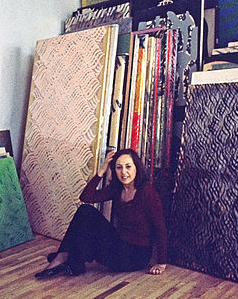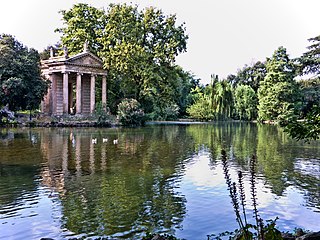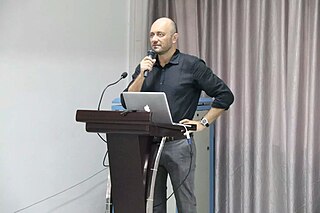
Villa Borghese is a landscape garden in Rome, containing a number of buildings, museums and attractions. It is the third-largest public park in Rome, after the ones of the Villa Doria Pamphili and Villa Ada. The gardens were developed for the Villa Borghese Pinciana, built by the architect Flaminio Ponzio, developing sketches by Scipione Borghese, who used it as a villa suburbana, or party villa, at the edge of Rome, and to house his art collection. The gardens as they are now were remade in the late 19th century.

The Galleria Nazionale d'Arte Moderna e Contemporanea, also known as La Galleria Nazionale, is an art museum in Rome. It was founded in 1883 on the initiative of the then minister Guido Baccelli and is dedicated to modern and contemporary art.

Enzo Cucchi is an Italian painter. A native of Morro d'Alba, province of Ancona, he was a key member of the Italian Transavanguardia movement, along with his countrymen Francesco Clemente, Mimmo Paladino, Nicola De Maria, and Sandro Chia. The movement was at its peak during the 1980s and was part of the worldwide movement of Neo-Expressionist painters.
Paolo Canevari is an Italian contemporary artist. He lives and works in New York City. Canevari presents highly recognizable, commonplace symbols in order to comment on such concept as religion, the urban myths of happiness or the major principles behind creation and destruction.

Carla Accardi was an Italian abstract painter associated with the Arte Informale and Arte Povera movements, and a founding member of the Italian art groups Forma (1947) and Continuità (1961).
Valentina Moncada di Paternò is an Italian art historian, gallery owner, and curator who specializes in contemporary art. In 1990 she opened an art gallery in Rome in Via Margutta 54, establishing herself as a talent scout due to a program of young international artists who soon became known worldwide.

The Galleria Comunale d'Arte Moderna is the museum of modern and contemporary art of the city of Rome, Italy. It is housed in a former Barefoot Carmelite monastery dating from the 17th century and adjacent to the church of San Giuseppe a Capo le Case, at 24 Via Francesco Crispi.

Bruno Ceccobelli is an Italian painter and sculptor. He currently resides and works in Todi, Italy. Ceccobelli was one of the six artists of the Nuova Scuola Romana or Scuola di San Lorenzo, an artistic movement that grew out of the Arte Povera and Transavanguardia movements of the latter twentieth century.

Stephen Antonakos was a Greek born American sculptor most well known for his abstract sculptures often incorporating neon.

The Museo di Roma is a museum in Rome, Italy, part of the network of Roman civic museums. The museum was founded in the Fascist era with the aim of documenting the local history and traditions of the "old Rome" that was rapidly disappearing, but following many donations and acquisitions of works of art is now principally an art museum. The collections initially included 120 water-colours by the nineteenth-century painter Ettore Roesler Franz of Roma sparita, "vanished Rome", later moved to the Museo di Roma in Trastevere.

Enzo Carnebianca, is a sculptor and painter born in Rome Italy.
Paolo Ventura is an Italian photographer, artist and set designer based in Milan.
Luca Pignatelli is an Italian artist.

Vito Bongiorno is an Italian artist known for making art out of charcoal.

The Villa Croce Museum of Contemporary Art is a permanent collection of Italian and international contemporary art hosted in a villa in the Carignano quarter of Genoa, northwestern Italy. The villa, donated to the city by the Croce family in 1951, is surrounded by public park with sea views, overhanging the Fiera di Genova exhibition center. It contains more than 3000 works of arts.

Pinciano is the 3rd quartiere of Rome (Italy), identified by the initials Q. III. The name derives from the Pincian Hill. It belongs to the Municipio II.

Salario is the 4th quarter of Rome (Italy), identified with the initials Q. IV.

Paolo Parisi is an Italian artist and professor of art.















